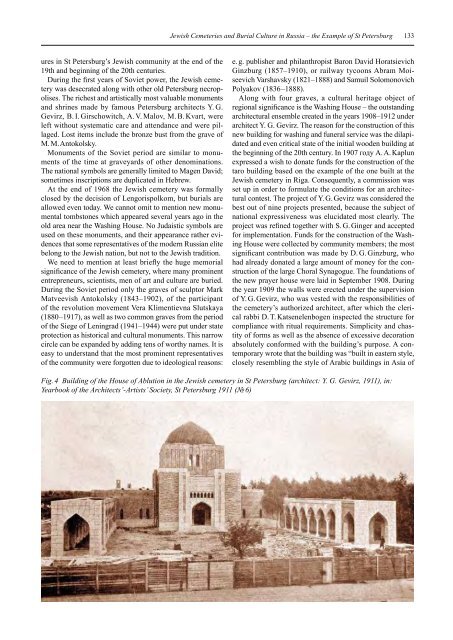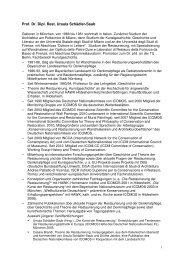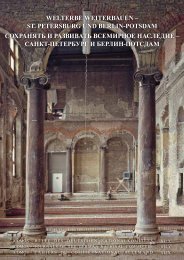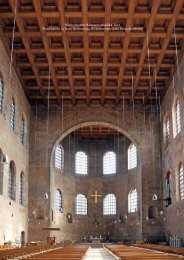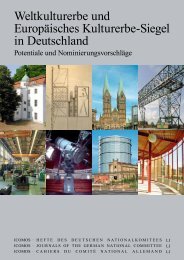Download der Publikation im PDF-Format - Icomos
Download der Publikation im PDF-Format - Icomos
Download der Publikation im PDF-Format - Icomos
Sie wollen auch ein ePaper? Erhöhen Sie die Reichweite Ihrer Titel.
YUMPU macht aus Druck-PDFs automatisch weboptimierte ePaper, die Google liebt.
Jewish Cemeteries and Burial Culture in Russia – the Example of St Petersburg<br />
133<br />
ures in St Petersburg’s Jewish community at the end of the<br />
19th and beginning of the 20th centuries.<br />
During the first years of Soviet power, the Jewish cemetery<br />
was desecrated along with other old Petersburg necropolises.<br />
The richest and artistically most valuable monuments<br />
and shrines made by famous Petersburg architects Y. G.<br />
Gevirz, B. I. Girschowitch, A. V. Malov, M. B. Kvart, were<br />
left without systematic care and attendance and were pillaged.<br />
Lost items include the bronze bust from the grave of<br />
M. M. Antokolsky.<br />
Monuments of the Soviet period are s<strong>im</strong>ilar to monuments<br />
of the t<strong>im</strong>e at graveyards of other denominations.<br />
The national symbols are generally l<strong>im</strong>ited to Magen David;<br />
somet<strong>im</strong>es inscriptions are duplicated in Hebrew.<br />
At the end of 1968 the Jewish cemetery was formally<br />
closed by the decision of Lengorispolkom, but burials are<br />
allowed even today. We cannot omit to mention new monumental<br />
tombstones which appeared several years ago in the<br />
old area near the Washing House. No Judaistic symbols are<br />
used on these monuments, and their appearance rather evidences<br />
that some representatives of the mo<strong>der</strong>n Russian elite<br />
belong to the Jewish nation, but not to the Jewish tradition.<br />
We need to mention at least briefly the huge memorial<br />
significance of the Jewish cemetery, where many prominent<br />
entrepreneurs, scientists, men of art and culture are buried.<br />
During the Soviet period only the graves of sculptor Mark<br />
Matveevish Antokolsky (1843–1902), of the participant<br />
of the revolution movement Vera Kl<strong>im</strong>entievna Slutskaya<br />
(1880 –1917), as well as two common graves from the period<br />
of the Siege of Leningrad (1941–1944) were put un<strong>der</strong> state<br />
protection as historical and cultural monuments. This narrow<br />
circle can be expanded by adding tens of worthy names. It is<br />
easy to un<strong>der</strong>stand that the most prominent representatives<br />
of the community were forgotten due to ideological reasons:<br />
e. g. publisher and philanthropist Baron David Horatsievich<br />
Ginzburg (1857–1910), or railway tycoons Abram Moiseevich<br />
Varshavsky (1821–1888) and Samuil Solomonovich<br />
Polyakov (1836 –1888).<br />
Along with four graves, a cultural heritage object of<br />
regional significance is the Washing House – the outstanding<br />
architectural ensemble created in the years 1908–1912 un<strong>der</strong><br />
architect Y. G. Gevirz. The reason for the construction of this<br />
new building for washing and funeral service was the dilapidated<br />
and even critical state of the initial wooden building at<br />
the beginning of the 20th century. In 1907 году А. А. Kaplun<br />
expressed a wish to donate funds for the construction of the<br />
taro building based on the example of the one built at the<br />
Jewish cemetery in Riga. Consequently, a commission was<br />
set up in or<strong>der</strong> to formulate the conditions for an architectural<br />
contest. The project of Y. G. Gevirz was consi<strong>der</strong>ed the<br />
best out of nine projects presented, because the subject of<br />
national expressiveness was elucidated most clearly. The<br />
project was refined together with S. G. Ginger and accepted<br />
for <strong>im</strong>plementation. Funds for the construction of the Washing<br />
House were collected by community members; the most<br />
significant contribution was made by D. G. Ginzburg, who<br />
had already donated a large amount of money for the construction<br />
of the large Choral Synagogue. The foundations of<br />
the new prayer house were laid in September 1908. During<br />
the year 1909 the walls were erected un<strong>der</strong> the supervision<br />
of Y. G. Gevirz, who was vested with the responsibilities of<br />
the cemetery’s authorized architect, after which the clerical<br />
rabbi D. T. Katsenelenbogen inspected the structure for<br />
compliance with ritual requirements. S<strong>im</strong>plicity and chastity<br />
of forms as well as the absence of excessive decoration<br />
absolutely conformed with the building’s purpose. A contemporary<br />
wrote that the building was “built in eastern style,<br />
closely resembling the style of Arabic buildings in Asia of<br />
Fig. 4 Building of the House of Ablution in the Jewish cemetery in St Petersburg (architect: Y. G. Gevirz, 1911), in:<br />
Yearbook of the Architects’-Artists’ Society, St Petersburg 1911 (№ 6)


